Reconfiguring Vertical Urbanism: The Example of Tall Buildings and Transit-Oriented Development (TB-TOD) in Hong Kong
Abstract
:1. Introduction
1.1. Background
1.2. Objectives
1.3. The TB-TOD Model
1.3.1. High Land Prices near Rail Stations
1.3.2. Increasing Ridership
1.3.3. Supporting Mixed-Use Activities
1.3.4. Accommodating a Substantial Number of Activities in a Limited Space
1.3.5. Curbing Sprawl
1.3.6. Fostering a Sense of Place
1.3.7. Economic Gain
2. Case Studies
2.1. “Plug-In” TB-TOD in the Old City
2.2. “City-Edge” TB-TOD
2.3. “One-Building” TB-TOD
2.4. “Suburban” TB-TOD in New Areas
3. Discussion
3.1. TB-TOD Characteristics
3.2. Spatial Structuring
3.3. Human-Scale Environment and Placemaking
3.3.1. The Ground Plane
3.3.2. The Tower Base
3.3.3. Tower Articulation
3.3.4. Streetscape
3.3.5. Public Spaces
3.3.6. Public Art as Placemaker
3.4. Mixed-Use Scheme
- Rosslyn: a first-class office and business center;
- Courthouse: the seat of the Arlington County government;
- Clarendon: an “urban village”;
- Virginia Square: a residential, cultural, and educational hub; and
- Ballston: a new downtown area.
3.5. Catchment Area
3.6. Iconicity and Symbolism
4. Conclusions
5. Future Research
Author Contributions
Funding
Institutional Review Board Statement
Informed Consent Statement
Data Availability Statement
Conflicts of Interest
References
- Al-Kodmany, K. Tall Buildings and the City: Improving the Understanding of Placemaking, Imageability, and Tourism; Springer Nature: Singapore, 2020. [Google Scholar]
- CTBUH, Skyscraper Center. Available online: http://skyscrapercenter.info/ (accessed on 6 February 2022).
- Al-Kodmany, K. New Suburbanism: Sustainable Tall Building Development; Routledge: London, UK, 2016. [Google Scholar]
- Binder, G. ‘A History of the World’s Tallest Building by Decade’, 100 of the World’s Tallest Building; Images Publishing: Mulgrave, VIC, Australia, 2015; pp. 18–31. [Google Scholar]
- Al-Kodmany, K. The Vertical City: A Sustainable Development Model; WIT Press: Southampton, UK, 2018. [Google Scholar]
- Al-Kodmany, K. New suburbanism: Sustainable spatial patterns of tall buildings. Buildings 2018, 8, 127. [Google Scholar] [CrossRef] [Green Version]
- Cervero, R.; Murakami, J. Rail and property development in Hong Kong: Experiences and extensions. Urban Stud. 2009, 46, 2019–2043. [Google Scholar] [CrossRef]
- Cervero, R.; Kockelman, K. Travel demand and the 3ds: Density, diversity, and design. Transp. Res. Part D Transp. Environ. 1997, 2, 199–219. [Google Scholar] [CrossRef]
- Renne, J.L. From transit-adjacent to transit-oriented development. Local Environ. 2009, 14, 1–15. [Google Scholar] [CrossRef]
- Ratner, K.A.; Goetz, A.R. The reshaping of landuse and urban form in Denver through transit-oriented development. Cities 2013, 30, 31–46. [Google Scholar] [CrossRef]
- Calthorpe, P. The Next American Metropolis: Ecology, Community & the American Dream; Princeton Architectural Press: New York, NY, USA, 1993. [Google Scholar]
- Bukowski, B.; Boatman, D.; Ramierz, K.; Du, M. A Comparative Study of Transit-oriented Development in Hong Kong; Hong Kong Institute of Education: Hong Kong, China, 2013. [Google Scholar]
- Xue, C.Q.L.; Sun, C. “Rail villages” in Hong Kong—Development ratio and design factors. Urban Des. Int. 2020, 26, 97–113. [Google Scholar] [CrossRef]
- Yin, Z. Study on Relationship between Catchment and Built Environment of Metro Station in Hong Kong and Shenzhen. Ph.D. Thesis, City University of Hong Kong, Hong Kong, China, 2014. [Google Scholar]
- Ng, E. (Ed.) Designing High-density Cities for Social and Environmental Sustainability; Earthscan: London, UK, 2010. [Google Scholar]
- Loo, B.; Chen, C.; Chan, E.T. Rail-based transit-oriented development: Lessons from New York City and Hong Kong. Landsc. Urban Plan. 2010, 97, 202–212. [Google Scholar] [CrossRef]
- Transportation Research Board. Transit-focused development: A synthesis of research and experience. In Transit Cooperative Research Program Report 20; Transportation Research Board: Washington, DC, USA, 1997. [Google Scholar]
- Knaap, G. Smart Growth and Urbanization in China: Can an American Tonic Treat the Growing Pains of Asia? In Proceedings of the Guangzhou: 2nd Megacities International Conference, Guangzhou, China, 1–2 December 2006. [Google Scholar]
- Knaap, G.J.; Ding, C.; Hopkins, L. Do plans matter? The effects of light rail plans on land values in station areas. J. Plan. Educ. Res. 2001, 1, 32–39. [Google Scholar] [CrossRef]
- Cervero, R. The Transit Metropolis—A Global Inquiry; Island Press: Washington, DC, USA, 1998. [Google Scholar]
- Xue, C.Q.L.; Ma, L.; Hui, K.C. Indoor “public” space—A study of atria in MTR complexes of Hong Kong. Urban Des. Int. 2012, 17, 87–105. [Google Scholar] [CrossRef]
- Lu, Y.; Gou, Z.; Xiao, Y.; Sarkar, C.; Zacharias, J. Do Transit-Oriented Developments (TODs) and Established Urban Neighborhoods Have Similar Walking Levels in Hong Kong? Int. J. Environ. Res. Public Heal. 2018, 15, 555. [Google Scholar] [CrossRef] [PubMed] [Green Version]
- Xue, F.; Gou, Z.; Lau, S.S.Y. Green open space in high-dense Asian cities: Site configurations, microclimates and users’ perceptions. Sustain. Cities Soc. 2017, 34, 114–125. [Google Scholar] [CrossRef]
- Al-Kodmany, K.; Mir, A. The Future of the City: Tall Buildings and Urban Design; WIT Press: Southampton, UK, 2013. [Google Scholar]
- Xue, C.Q.L. Hong Kong Architecture 1945–2015: From Colonial to Global; Springer: Singapore, 2016. [Google Scholar]
- Tan, Z.; Xue, C.Q. The Evolution of an Urban Vision—Multilevel Pedestrian Networks in Hong Kong, 1965–1997. J. Urban Hist. 2016, 42, 688–708. [Google Scholar] [CrossRef]
- Al-Kodmany, K. Improving the Understanding of City Spaces for Tourism Applications. Buildings 2019, 9, 187. [Google Scholar] [CrossRef] [Green Version]
- Al-Kodmany, K. Sustainability and the 21st Century Vertical City: A Review of Design Approaches of Tall Buildings. Buildings 2018, 8, 102. [Google Scholar] [CrossRef] [Green Version]
- Xue, C.Q.; Zhai, H.; Roberts, J. An urban island floating on the MTR station: A case study of the West Kowloon development in Hong Kong. Urban Des. Int. 2010, 15, 191–207. [Google Scholar] [CrossRef]
- Zang, P.; Xue, C.; Lu, Y.; Tu, K. Neighborhood adaptability for Hong Kong Al g’s ageing population. Urban Des. Int. 2019, 24, 187–205. [Google Scholar] [CrossRef]
- Al, S. Mall City: Hong Kong’s Dreamworlds of Consumption; University of Hawaii Press: Honolulu, HI, USA, 2016. [Google Scholar]
- Tan, Z.; Xue, C.Q.L. Walking as a planned activity—elevated pedestrian network and urban design regulation in Hong Kong. J. Urban Design 2014, 19, 722–744. [Google Scholar] [CrossRef]
- MTRC. Annual Report of Fiscal Year; Mass Transit Railway Corporation: Hong Kong, China, 2015. [Google Scholar]
- Shelton, B.; Karakiewicz, J.; Kvan, T. The Making of Hong Kong—From Vertical to Volumetric; Routledge: New York, NY, USA, 2011. [Google Scholar]
- Tang, B.S.; Chiang, Y.; Baldwin, A.; Yeung, C.W. Study of the Integrated Rail-Property Development Model in Hong Kong, Research Center for Construction & Real Estate Economics; Department of Building & Real Estate, Hong Kong Polytechnic University: Hong Kong, China, 2004. [Google Scholar]
- Terry Farrell & Partners. Kowloon Transport Super City; Pace Publishing Ltd.: Hong Kong, China, 1998. [Google Scholar]
- Chau, K.; Ng, F. The effects of improvement in public transportation capacity on residential price gradient in Hong Kong. J. Prop. Valuat. Invest. 1998, 16, 397–410. [Google Scholar] [CrossRef]
- Bosselmann, P.; Macdonald, E.; Kronemeyer, T. Livable Streets Revisited. J. Am. Plan. Assoc. 1999, 65, 168–180. [Google Scholar] [CrossRef]
- Al-Kodmany, K. Understanding Tall Buildings: A Theory of Placemaking; Routledge: New York, NY, USA, 2017. [Google Scholar]
- Al-Kodmany, K. Planning Guidelines for Enhancing Placemaking with Tall Buildings. Int. J. Archit. Res. 2018, 12, 5–23. [Google Scholar] [CrossRef]
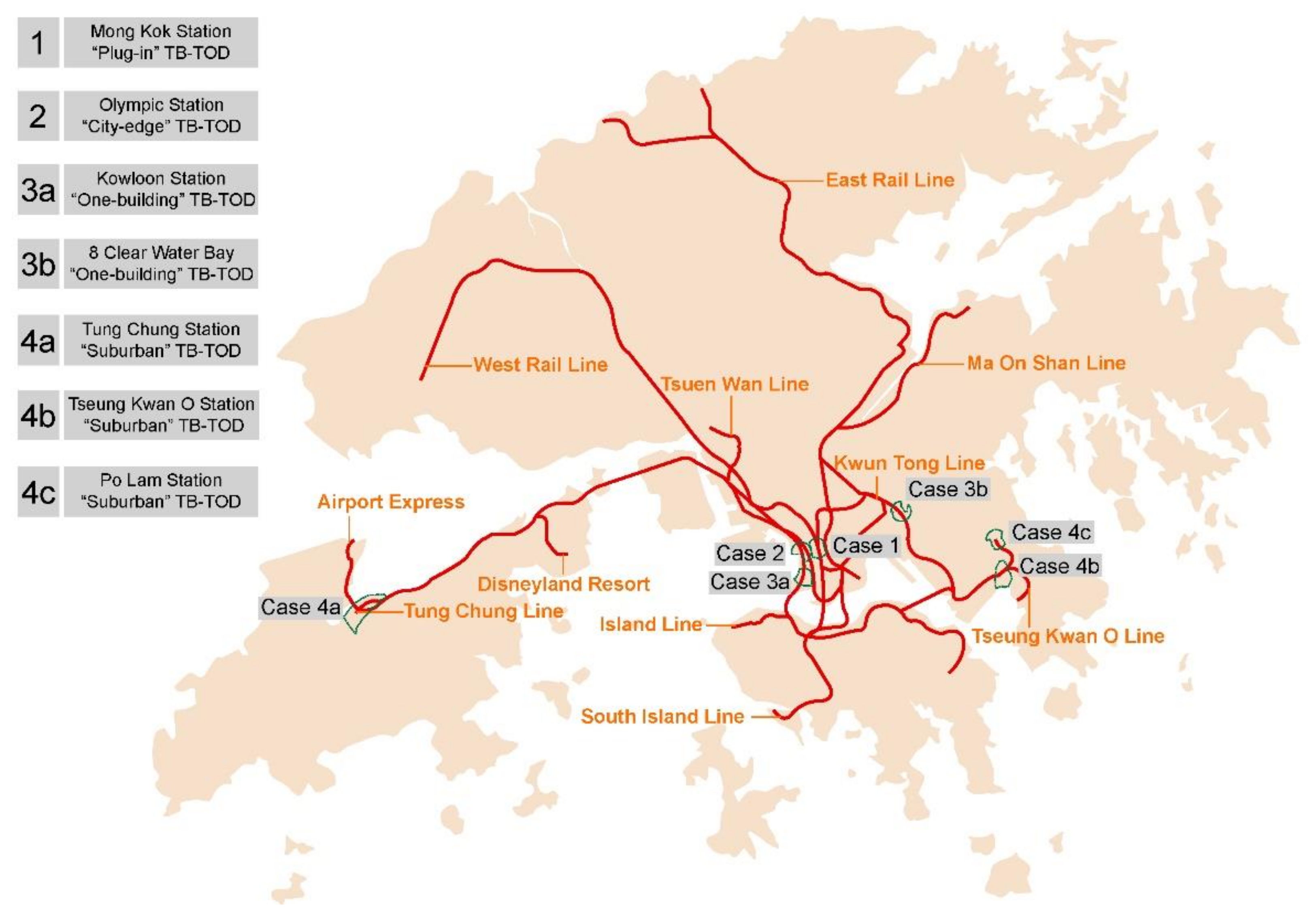
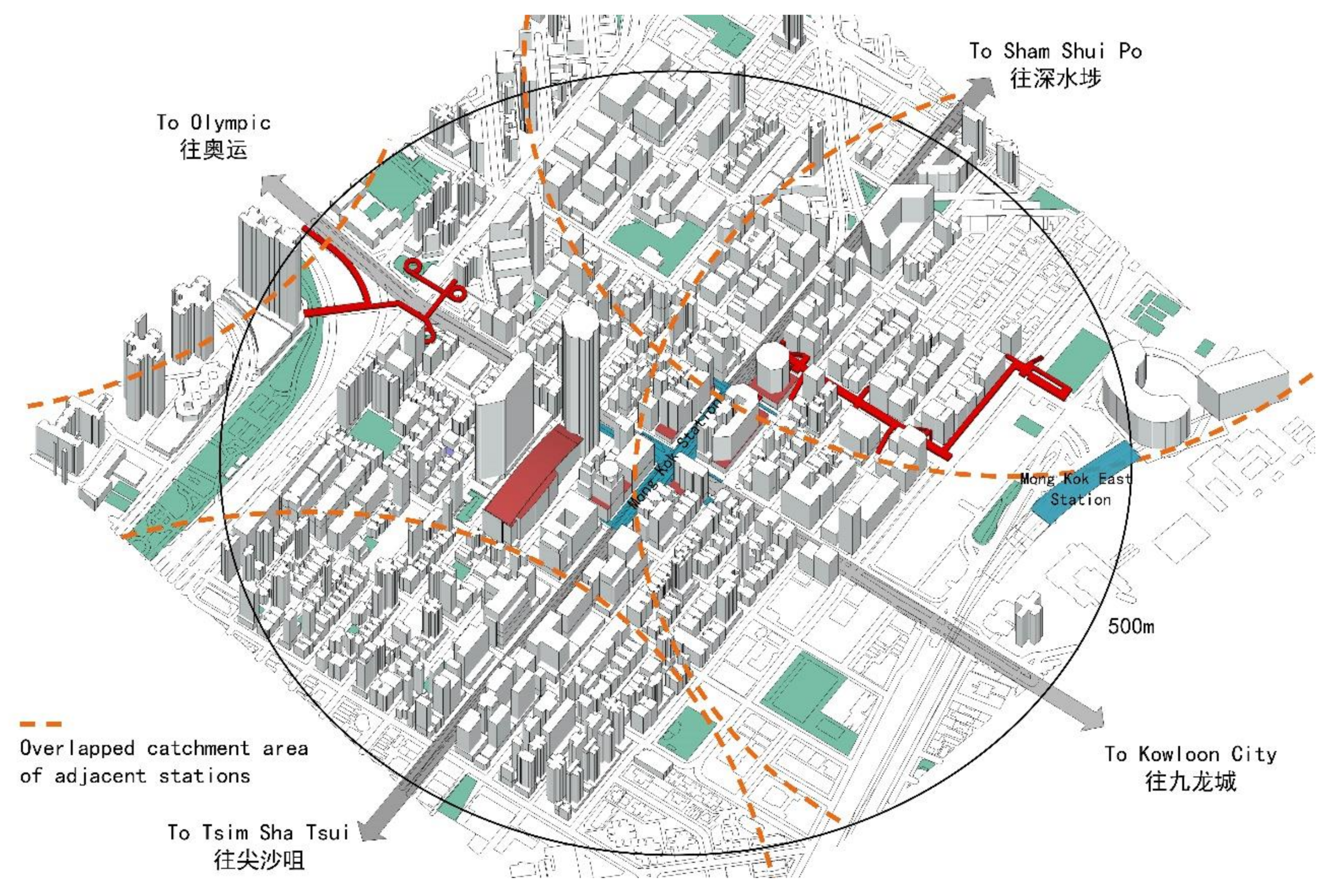
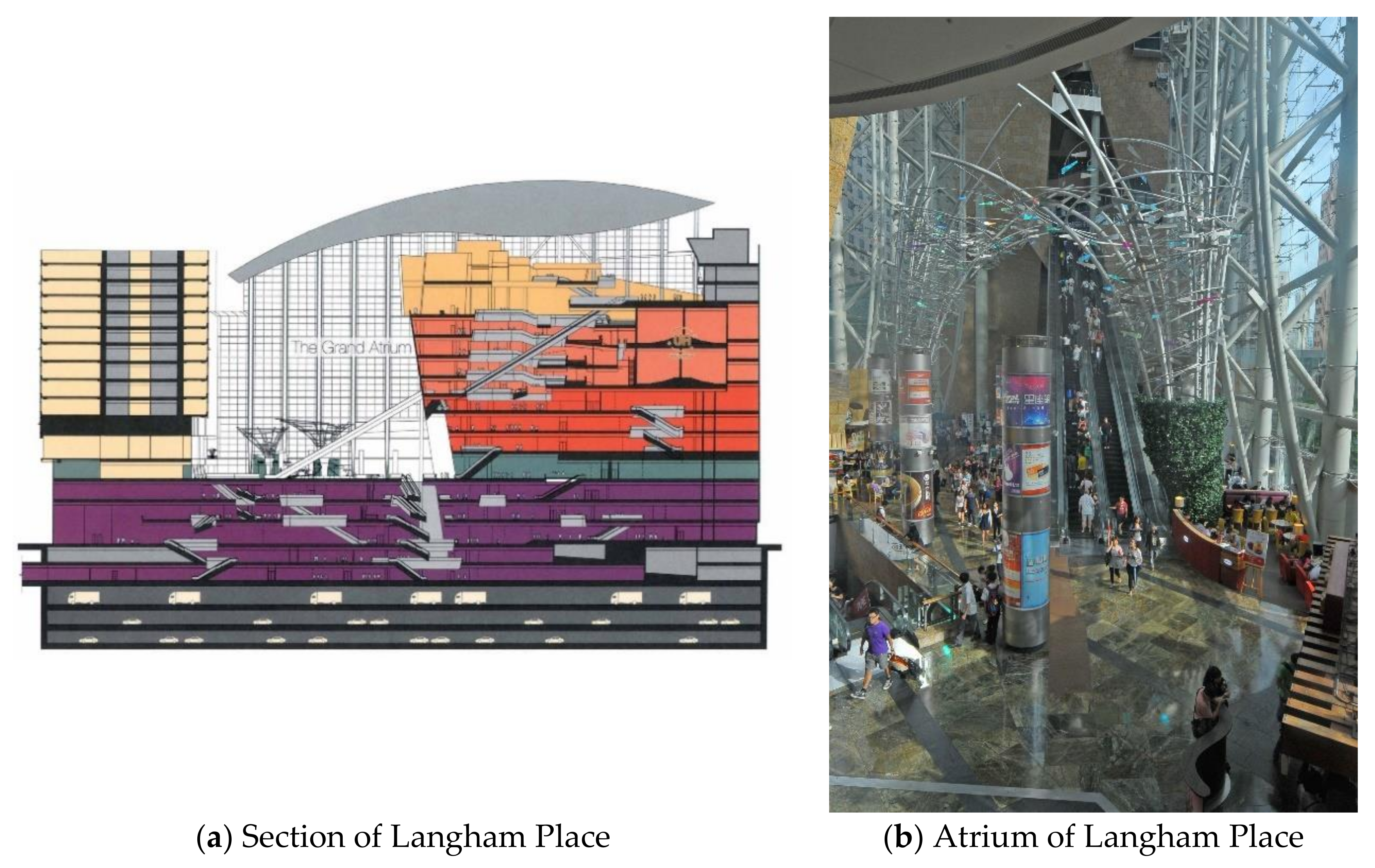
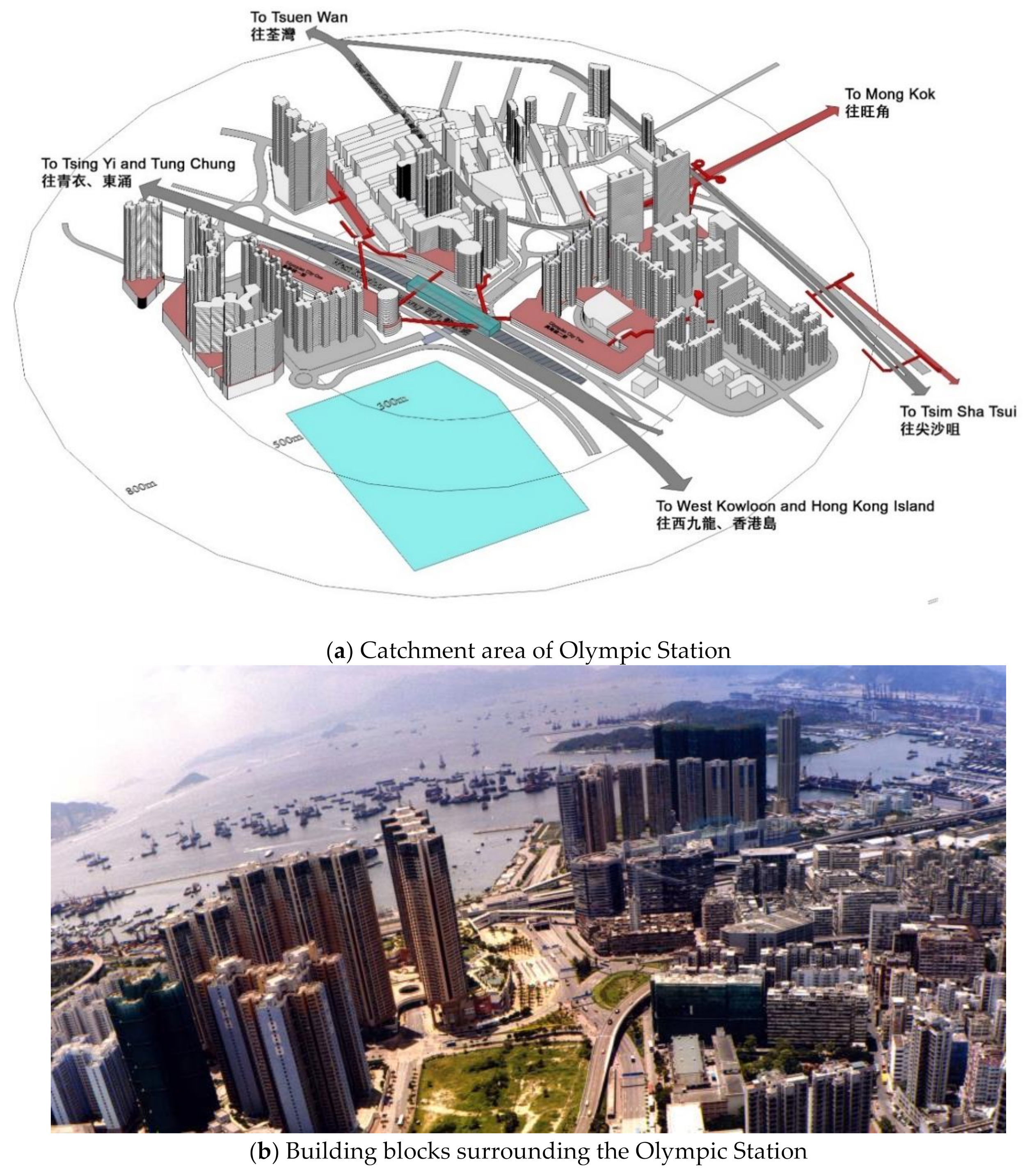

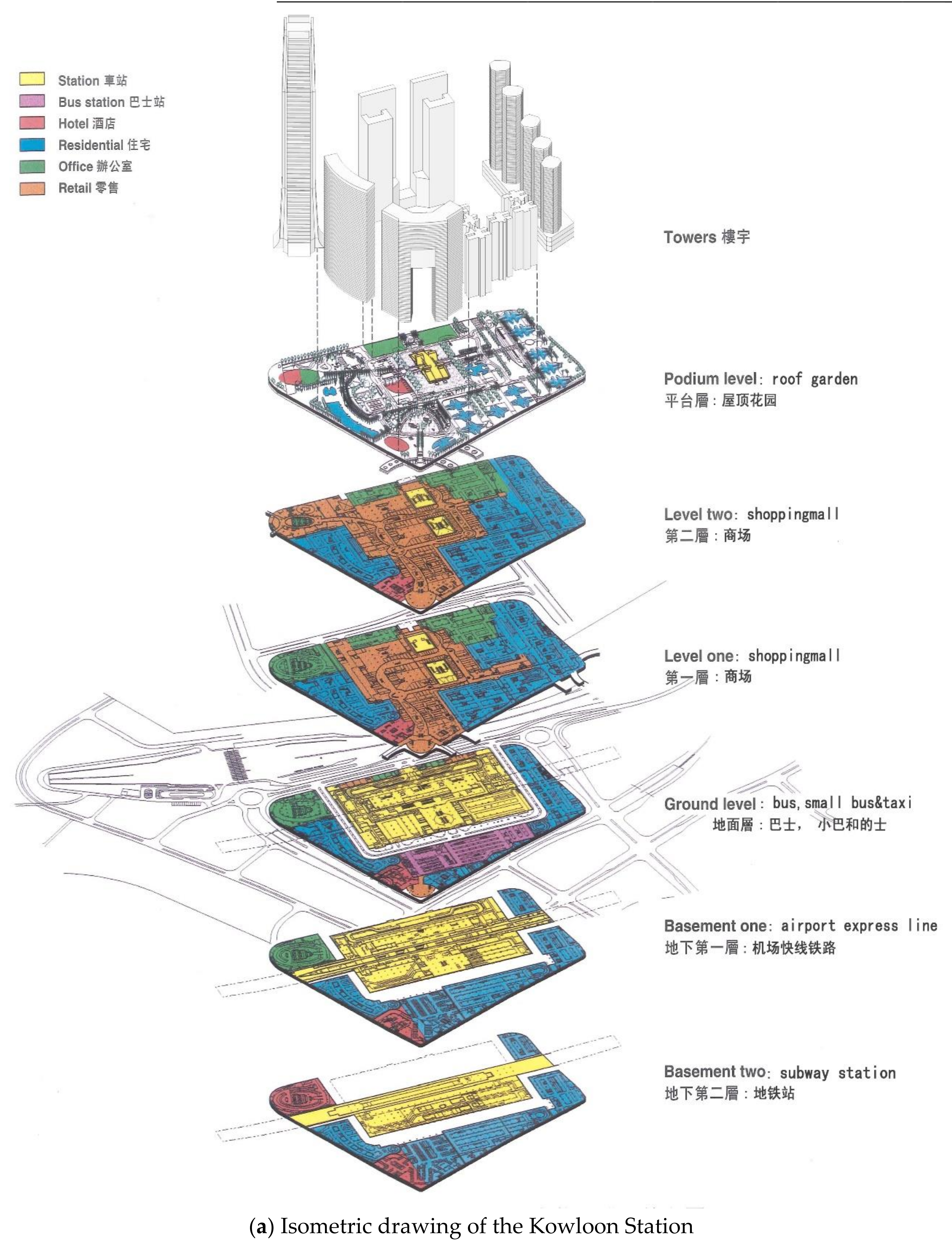
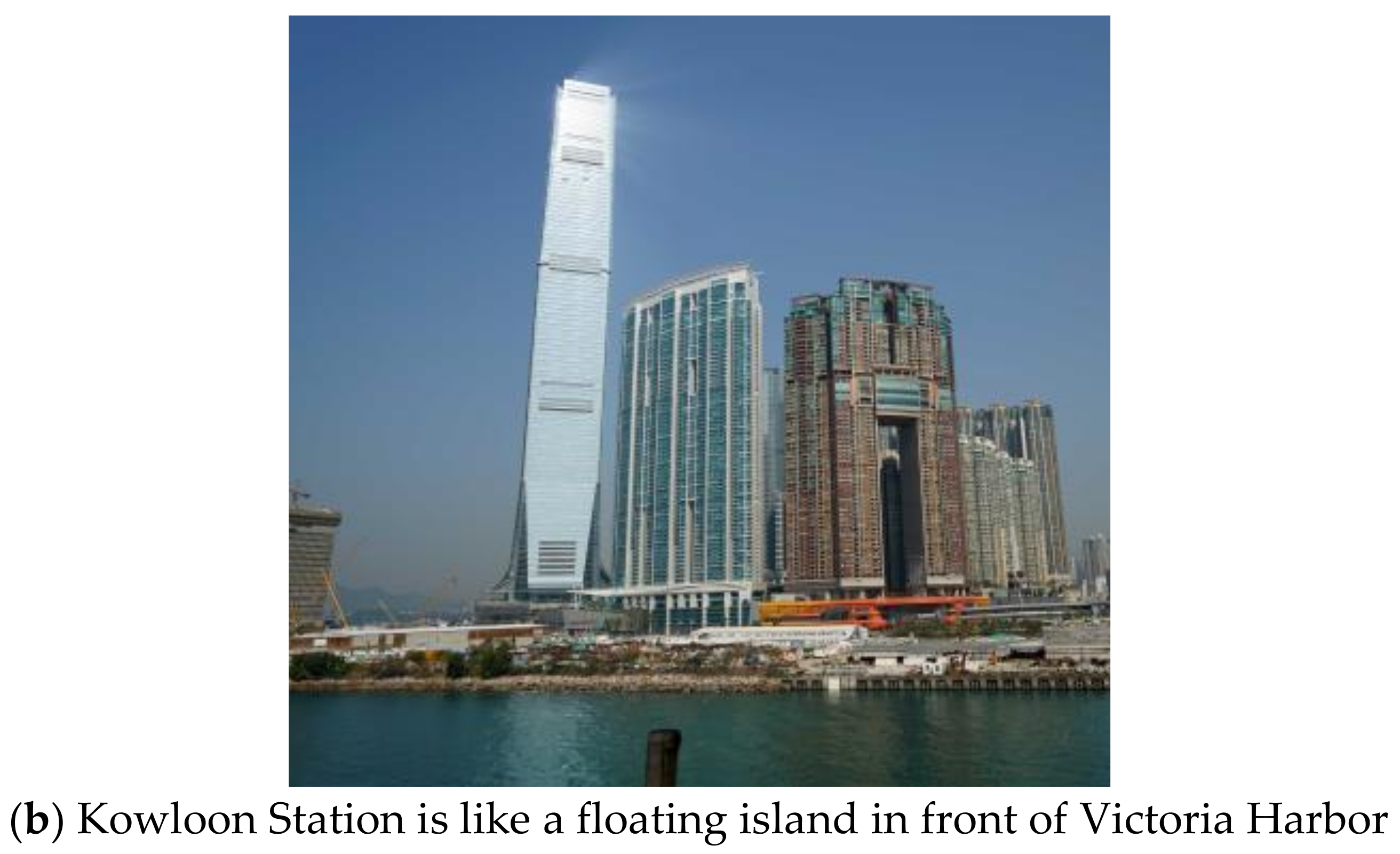
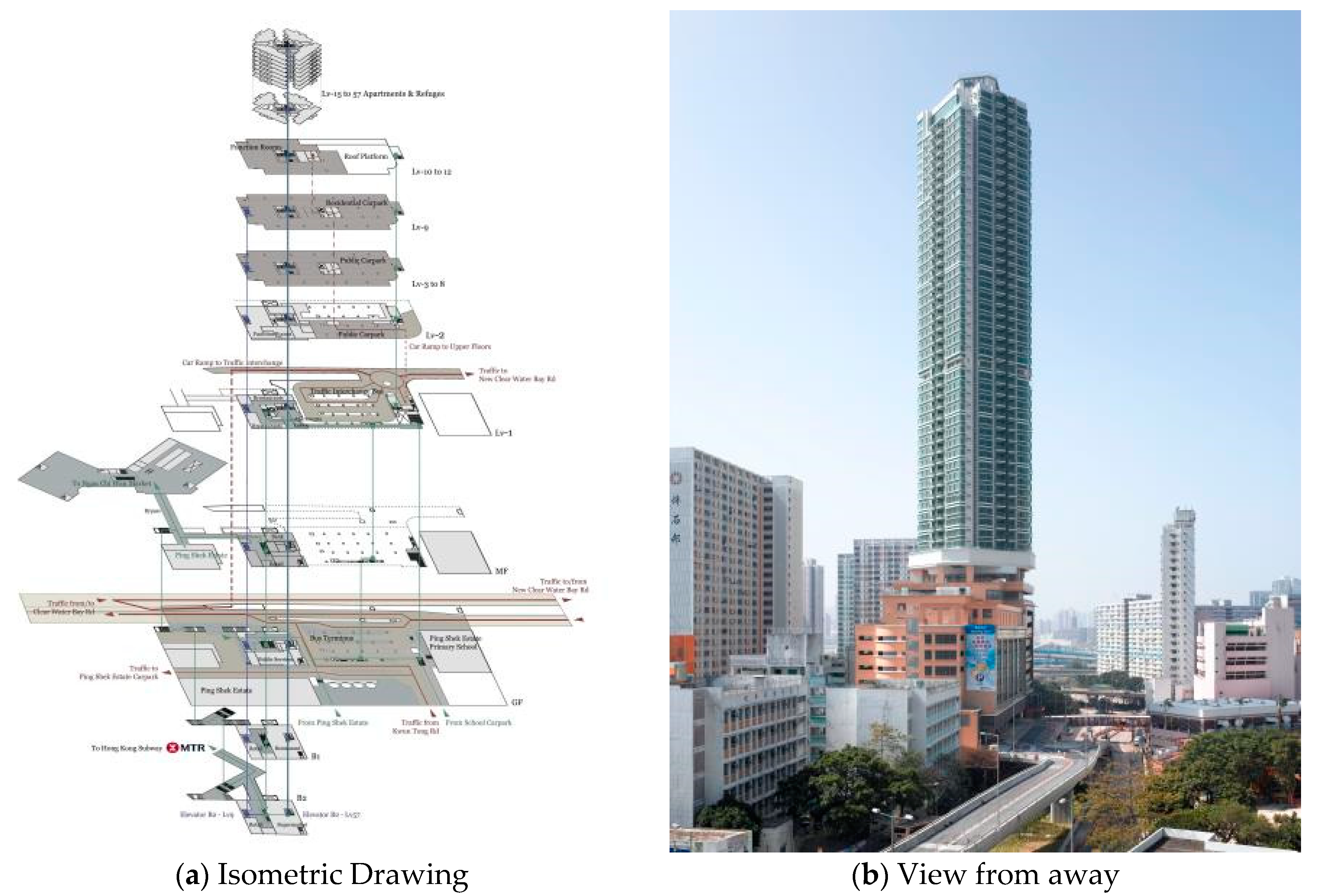
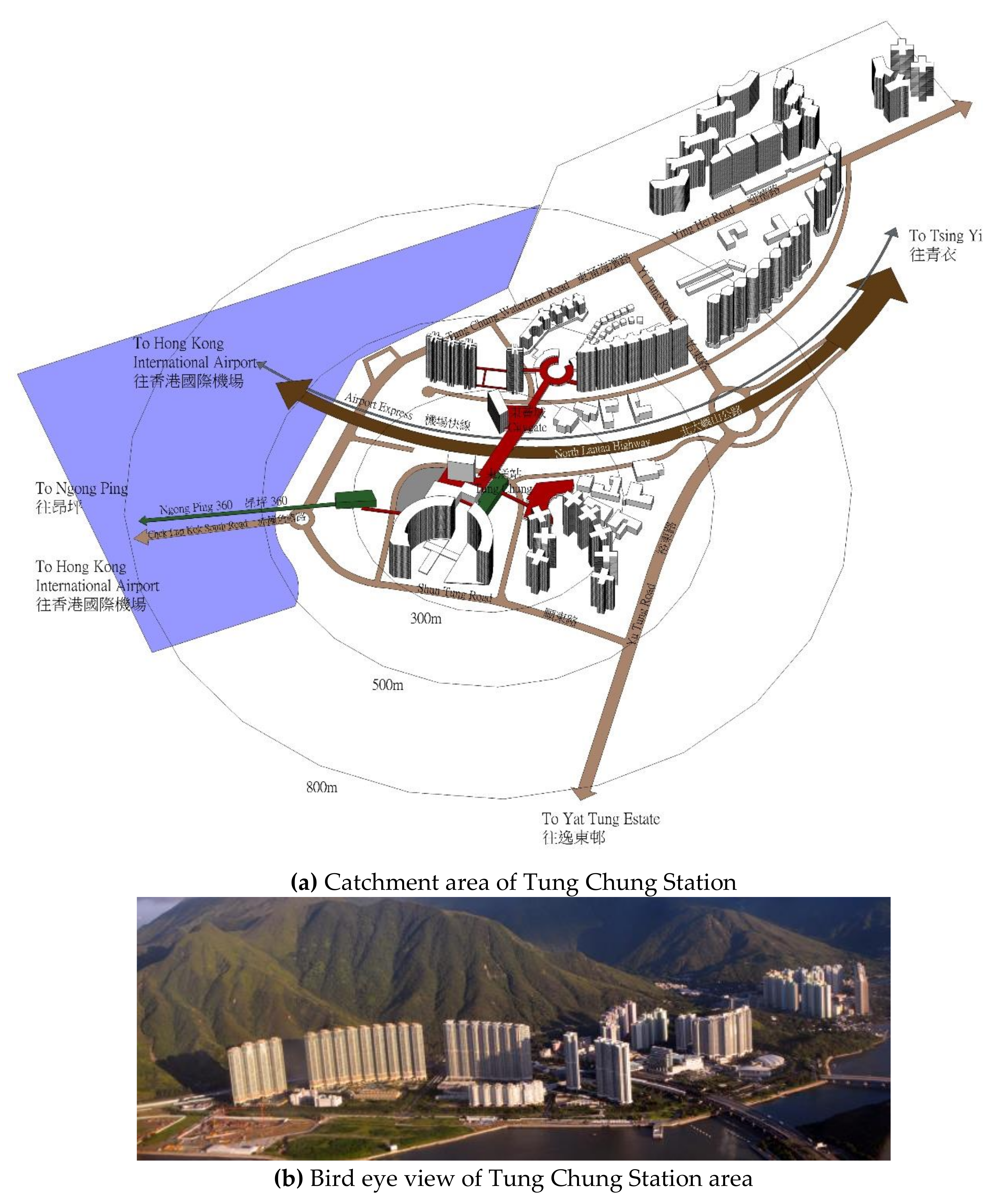
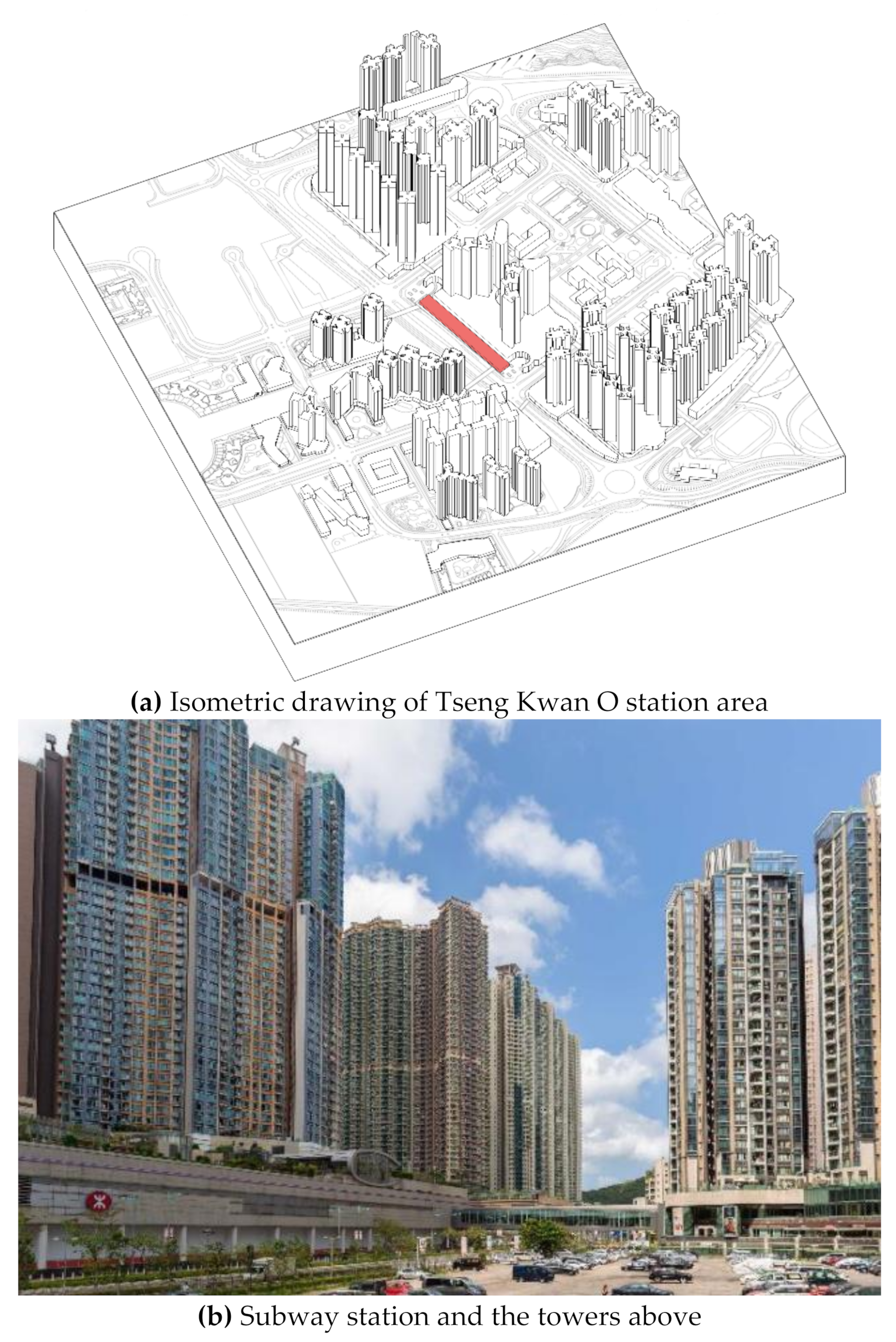
| Continent | Cities | Number of Tall Buildings Constructed Prior to the 21st Century | Numberof Tall Buildings Constructed in the 21st Century | Total Number of Tall Buildings Constructed on each continent | Rank |
|---|---|---|---|---|---|
| Asia | Shanghai, Shenzhen, Tokyo, Osaka, Bangkok, Seoul, Jakarta, Manila, and Singapore | 1011 | 3986 | 4997 | 1 |
| North America | New York City, Chicago, Philadelphia, San Francisco, Los Angeles, Toronto, Vancouver, and Calgary | 2022 | 1459 | 3481 | 2 |
| Europe | London, Paris, Frankfurt, Amsterdam, Moscow, and Warsaw | 322 | 651 | 973 | 3 |
| Middle East | Doha, Jeddah, Mecca, Riyadh, Kuwait, Dubai, and Abu Dubai | 64 | 574 | 638 | 4 |
| South America | Santiago, Cartagena, Buenos Aires, and São Paulo | 182 | 427 | 609 | 5 |
| Oceania | Sydney, Melbourne, Perth, | 185 | 258 | 443 | 6 |
| Africa | Johannesburg, Pretoria, Sandton, Dar es Salaam, Nairobi, and Lagos | 85 | 46 | 131 | 7 |
| Central America | Panama City, Mexico City, Monterrey, and Guadalajara | 11 | 78 | 89 | 8 |
| Total | 3882 | 7479 | 11,361 | ||
| Building Type | Name | Height (m) | Completed Year | Numbers of Towers | Number of Floors | Designer |
|---|---|---|---|---|---|---|
| High-grade residential | The Waterfront | 142 | 2000 | 6 | 42 | Kwan & Associates Architects Limited |
| The Sorrento | 256.3 | 2003 | 5 | 74 | Wong & Ouyang (HK) Ltd. | |
| The HarbourSide | 251 | 2003 | 3 | 74 | P & T Architects and Engineers Ltd. | |
| The Arch | 231 | 2005 | 4 | 65 | Sun Hung Kai Architects and Engineers Ltd. | |
| Retail | Elements | 18 | 2007 | - | 2 | Benoy |
| Mix-use | The Cullinan | 270 | 2009 | 2 | 68 | Wong & Ouyang (HK) Ltd. |
| International Commerce Center | 484 | 2010 | 1 | 108 | Kohn Pedersen Fox Association |
| Type | Megastructure | Pencil-Building |
|---|---|---|
| Station | Kowloon Station | Choi Hung Station (8 Clear Water Bay Road) |
| Functional Composition | A transportation hub + an iconic mix-use building + a high-end shopping center + high-grade residentials + 2 luxury hotels | A transportation hub + community-focused retails + the transit body connecting community utilities to the subway + residentials |
| Height | 484 m | 171 m |
| Composition | 18 high-grade residential towers, 1 3-story podium for retail, 2 mix-use towers, 1 multi-functional landmark tower, 1 3-story public transport interchange | 40-story residential tower, 8-story parking tower, 5-story shopping mall, 2-story public transport interchange |
| GFA | 1,697,552 m2 | 32,500 m2 |
| Density | 12.5 | 13.5 |
| Land area | 135,417 m2 | 2400 m2 |
| Development Year | 1996–2010 | 2006 |
| Station | Tung Chung Station | Tseung Kwan O Station |
|---|---|---|
| Functional Composition | Outlet mall + more affordable residential + public housing estate + office building + high-end hotel + municipal supporting facilities | community-focused retail + more affordable residential + public housing estate + hotels + municipal supporting facilities |
| Height | 215 m | 162 m |
| Composition | 72 residential towers, a ten-story shopping mall, a nine-story commercial building, one 23-story and two 18-story hotel buildings | 115 residential towers, 8 community-focused shopping malls, two 41-story hotels |
| GFA | 2,132,489 m2 | 2,539,868 m2 |
| Density | 1.43 | 2.63 |
| Land area | 1,489,257 m2 | 966,068 m2 |
| Development Year | 1998–2020 | 1998–2018 |
| Type | Building Type and Function | No. of Floors and Shape of Tall Buildings | Catchment Area (ha) | Approximate Catchment Radius (m) | Floor Area of Buildings in the Catchment Area (m2) | Locations of Exits | |
|---|---|---|---|---|---|---|---|
| Mong Kok Station | Plug-in TOD in old city | “Ginza”-style retail and office buildings, old tenement houses. | Mostly 20 to 30 stories; 12-level shopping mall in Langham Place. | 61.3 | 380–500 | 2,800,000 | Six exits, two leading to the shopping mall, two to a pocket of open space. |
| Olympic Station | City-edge, combination of old and new areas | Shopping mall, residential, office, boutique hotel. | 35–60-story residential towers on a podium. | 84 (after deductionof the sea area) | 600 | 1,768,859 | Six exits, all bridges leading to the shopping mall and commercial areas. |
| Kowloon Station | One-building megastructure | Shopping mall, residential towers, hotel, office | 100-story office tower, 40–90-story residential towers. | 13.5 | Podium 369 × 503 | 1,697,552 (one-building complex) | Exits all leading to the building complex. |
| 8 Clear Water Bay (Choi Hung Station) | One-building “pencil tower” | Residential, retail, market | 45-story residential tower above the podium. | Building plate plus immediate site. 30 × 80 m | The building extends to a wet market, schools, and a community hall in a 200 m radius. | 32,500 (one building) | An exit in the basement of the tower. |
| Tung Chung Station | Suburban TOD | Shopping mall, residential, hotel | 60-story residential towers. | 149 | 1200 | 2,132,489 | Exits leading to the shopping mall and public space. |
| Tseung Kwan O Station | Suburban TOD | Shopping mall, residential, hotel | 50-story residential towers on a commercial podium. | 96 | 600 | 2,539,868 | Exits leading to the shopping mall and a bridge to the streets. |
| Po Lam Station | Suburban TOD | Shopping mall and residential | 40–50-story residential towers surrounding shopping malls. | 78.5 | 500 | 2,287,860 | Exits leading to the shopping mall and a bridge to the streets. |
Publisher’s Note: MDPI stays neutral with regard to jurisdictional claims in published maps and institutional affiliations. |
© 2022 by the authors. Licensee MDPI, Basel, Switzerland. This article is an open access article distributed under the terms and conditions of the Creative Commons Attribution (CC BY) license (https://creativecommons.org/licenses/by/4.0/).
Share and Cite
Al-Kodmany, K.; Xue, Q.; Sun, C. Reconfiguring Vertical Urbanism: The Example of Tall Buildings and Transit-Oriented Development (TB-TOD) in Hong Kong. Buildings 2022, 12, 197. https://doi.org/10.3390/buildings12020197
Al-Kodmany K, Xue Q, Sun C. Reconfiguring Vertical Urbanism: The Example of Tall Buildings and Transit-Oriented Development (TB-TOD) in Hong Kong. Buildings. 2022; 12(2):197. https://doi.org/10.3390/buildings12020197
Chicago/Turabian StyleAl-Kodmany, Kheir, Qiuli (Charlie) Xue, and Cong Sun. 2022. "Reconfiguring Vertical Urbanism: The Example of Tall Buildings and Transit-Oriented Development (TB-TOD) in Hong Kong" Buildings 12, no. 2: 197. https://doi.org/10.3390/buildings12020197
APA StyleAl-Kodmany, K., Xue, Q., & Sun, C. (2022). Reconfiguring Vertical Urbanism: The Example of Tall Buildings and Transit-Oriented Development (TB-TOD) in Hong Kong. Buildings, 12(2), 197. https://doi.org/10.3390/buildings12020197







